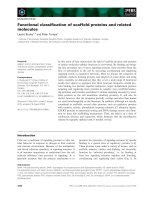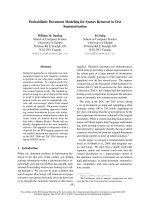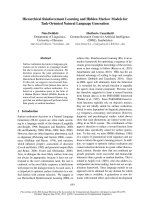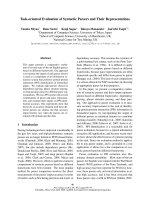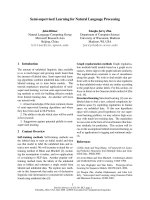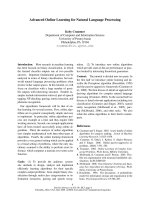Báo cáo khoa học: "Hierarchical Sequential Learning for Extracting Opinions and their Attributes" ppt
Bạn đang xem bản rút gọn của tài liệu. Xem và tải ngay bản đầy đủ của tài liệu tại đây (185.24 KB, 6 trang )
Proceedings of the ACL 2010 Conference Short Papers, pages 269–274,
Uppsala, Sweden, 11-16 July 2010.
c
2010 Association for Computational Linguistics
Hierarchical Sequential Learning for Extracting Opinions and their
Attributes
Yejin Choi and Claire Cardie
Department of Computer Science
Cornell University
Ithaca, NY 14853
{ychoi,cardie}@cs.cornell.edu
Abstract
Automatic opinion recognition involves a
number of related tasks, such as identi-
fying the boundaries of opinion expres-
sion, determining their polarity, and de-
termining their intensity. Although much
progress has been made in this area, ex-
isting research typically treats each of the
above tasks in isolation. In this paper,
we apply a hierarchical parameter shar-
ing technique using Conditional Random
Fields for fine-grained opinion analysis,
jointly detecting the boundaries of opinion
expressions as well as determining two of
their key attributes — polarity and inten-
sity. Our experimental results show that
our proposed approach improves the per-
formance over a baseline that does not
exploit hierarchical structure among the
classes. In addition, we find that the joint
approach outperforms a baseline that is
based on cascading two separate compo-
nents.
1 Introduction
Automatic opinion recognition involves a number
of related tasks, such as identifying expressions of
opinion (e.g. Kim and Hovy (2005), Popescu and
Etzioni (2005), Breck et al. (2007)), determining
their polarity (e.g. Hu and Liu (2004), Kim and
Hovy (2004), Wilson et al. (2005)), and determin-
ing their strength, or intensity (e.g. Popescu and
Etzioni (2005), Wilson et al. (2006)). Most pre-
vious work treats each subtask in isolation: opin-
ion expression extraction (i.e. detecting the bound-
aries of opinion expressions) and opinion attribute
classification (e.g. determining values for polar-
ity and intensity) are tackled as separate steps in
opinion recognition systems. Unfortunately, er-
rors from individual components will propagate in
systems with cascaded component architectures,
causing performance degradation in the end-to-
end system (e.g. Finkel et al. (2006)) — in our
case, in the end-to-end opinion recognition sys-
tem.
In this paper, we apply a hierarchical param-
eter sharing technique (e.g., Cai and Hofmann
(2004), Zhao et al. (2008)) using Conditional Ran-
dom F ields (CRFs) (Lafferty et al., 2001) to fine-
grained opinion analysis. In particular, we aim to
jointly identify the boundaries of opinion expres-
sions as well as to determine two of their key at-
tributes — polarity and intensity.
Experimental results show that our proposed ap-
proach improves the performance over the base-
line that does not exploit the hierarchical structure
among the classes. In addition, we find that the
joint approach outperforms a baseline that is based
on cascading two separate systems.
2 Hierarchical Sequential Learning
We define the problem of joint extraction of opin-
ion expressions and their attributes as a sequence
tagging task as follows. Given a sequence of to-
kens, x = x
1
x
n
, we predict a sequence of
labels, y = y
1
y
n
, where y
i
∈ {0, , 9} are
defined as conjunctive values of polarity labels
and intensity labels, as shown in Table 1. Then
the conditional probability p(y|x) for linear-chain
CRFs is given as (Lafferty et al., 2001)
P (y|x) =
1
Z
x
exp
i
λ f(y
i
, x, i)+λ
′
f
′
(y
i−1
, y
i
, x, i)
where Z
x
is the normalization factor.
In order to apply a hierarchical parameter shar-
ing technique (e.g., Cai and Hofmann (2004),
Zhao et al. (2008)), we extend parameters as fol-
lows.
269
Figure 1: The hierarchical structure of classes for opinion expressions with polarity (positive, neutral,
negative) and intensity (high, medium, low)
LABEL 0 1 2 3 4 5 6 7 8 9
POLARITY none positive positive positive neutral neutral neutral negative negative negative
INTENSITY none high medium low high medium low high medium low
Table 1: Labels for Opinion Extraction with Polarity and Intensity
λ f(y
i
, x, i) = λ
α
g
O
(α, x, i) (1)
+ λ
β
g
P
(β, x, i)
+ λ
γ
g
S
(γ, x, i)
λ
′
f
′
(y
i−1
, y
i
, x, i) = λ
′
α, ˆα
g
′
O
(α, ˆα, x, i)
+ λ
′
β,
ˆ
β
g
′
P
(β,
ˆ
β, x, i)
+ λ
′
γ,ˆγ
g
′
S
(γ, ˆγ, x, i)
where g
O
and g
′
O
are feature vectors defined for
Opinion extraction, g
P
and g
′
P
are feature vectors
defined for Polarity extraction, and g
S
and g
′
S
are
feature vectors defined for Strength extraction, and
α, ˆα ∈ {OPINION, NO-OPINION}
β,
ˆ
β ∈ {POSITIVE, NEGATIVE, NEUTRAL, NO-POLARITY}
γ, ˆγ ∈ {HIGH, MEDIUM, LOW, NO-INTENSITY}
For instance, if y
i
= 1, then
λ f(1, x, i) = λ
OPINION
g
O
(OPINION, x, i)
+ λ
POSITIVE
g
P
(POSITVE, x, i)
+ λ
HIGH
g
S
(HIGH, x, i)
If y
i−1
= 0, y
i
= 4, then
λ
′
f
′
(0, 4, x, i)
= λ
′
NO- OPINION,OPINION
g
′
O
(NO-OPINION, OPINION, x, i)
+ λ
′
NO- POLARITY, NEUTRAL
g
′
P
(NO-POLARITY, NEUTRAL, x, i)
+ λ
′
NO- INTENSITY, HIGH
g
′
S
(NO-INTENSITY, HIGH, x, i)
This hierarchical construction of feature and
weight vectors allows similar labels to share the
same subcomponents of feature and weight vec-
tors. For instance, all λ f(y
i
, x, i) such that
y
i
∈ {1, 2, 3} will share the same compo-
nent λ
POSITIVE
g
P
(POSITVE, x, i). Note that there
can be other variations of hierarchical construc-
tion. For instance, one can add λ
δ
g
I
(δ, x, i)
and λ
′
δ,
ˆ
δ
g
′
I
(δ,
ˆ
δ, x, i) to Equation (1) for δ ∈
{0, 1, , 9}, in order to allow more individualized
learning for each label.
Notice also that the number of sets of param-
eters constructed by Equation (1) is significantly
smaller than the number of sets of parameters that
are needed without the hierarchy. The former re-
quires (2 + 4 + 4) + (2 × 2 + 4 × 4 + 4 × 4) = 46
sets of parameters, but the latter requires (10) +
(10 × 10) = 110 sets of parameters. Because a
combination of a polarity component and an in-
tensity component can distinguish each label, it is
not necessary to define a separate set of parameters
for each label.
3 Features
We first introduce definitions of key terms that will
be used to describe features.
• PRIOR-POLARITY & PRIOR-INTENSITY:
We obtain these prior-attributes from the polar-
ity lexicon populated by Wilson et al. (2005).
• EXP-POLARITY, EXP-INTENSITY & EXP-SPAN:
Words in a given opinion expression often do
not share the same prior-attributes. Such dis-
continuous distribution of features can make
it harder to learn the desired opinion expres-
sion boundaries. Therefore, we try to obtain
expression-level attributes (EXP-POLARITY and
EXP-INTENSITY) using simple heuristics. In or-
der to derive EXP-POLARITY, we perform simple
270
voting. If there is a word with a negation effect,
such as “never”, “not”, “hardly”, “against”, then
we flip the polarity. For EXP-INTENSITY, we use
the highest PRIOR-INTENSITY in the span. The text
span with the same expression-level attributes
are referred to as EXP-SPAN.
3.1 Per-Token Features
Per-token features are defined in the form of
g
O
(α, x, i), g
P
(β, x, i) and g
S
(γ, x, i). The do-
mains of α, β, γ are as given in Section 3.
Common Per-Token Features
Following features are common for all class labels.
The notation ⊗ indicates conjunctive operation of
two values.
• PART-OF-SPEECH(x
i
) :
based on GATE (Cunningham et al., 2002).
• WORD(x
i
) , WORD(x
i−1
) , WORD(x
i+1
)
• WORDNET-HYPERNYM(x
i
) :
based on WordNet (Miller, 1995).
• OPINION-LEXICON(x
i
) :
based on opinion lexicon (Wiebe et al., 2002).
• SHALLOW-PARSER(x
i
) :
based on CASS partial parser (Abney, 1996).
• PRIOR-POLARITY(x
i
) ⊗ PRIOR-INTENSITY(x
i
)
• EXP-POLARITY(x
i
) ⊗ EXP-INTENSITY(x
i
)
• EXP-POLARITY(x
i
) ⊗ EXP-INTENSITY(x
i
) ⊗
STEM(x
i
)
• EXP-SPAN(x
i
) :
boolean to indicate whether x
i
is in an EXP-SPAN.
• DISTANCE-TO-EXP-SPAN(x
i
) : 0, 1, 2, 3+.
• EXP-POLARITY(x
i
) ⊗ EXP-INTENSITY(x
i
) ⊗
EXP-SPAN(x
i
)
Polarity Per-Token Features
These features are included only for g
O
(α, x, i)
and g
P
(β, x, i), which are the feature functions
corresponding to the polarity-based classes.
• PRIOR-POLARITY(x
i
) , EXP-POLARITY((x
i
)
• STEM(x
i
) ⊗ E XP-POLARITY(x
i
)
• COUNT-OF-P olarity:
where P olarity ∈ {positive, neutral, negative}.
This feature encodes the number of positive,
neutral, and negative EXP-POLARITY words re-
spectively, in the current sentence.
• STEM(x
i
) ⊗ COUNT-OF-P olarity
• EXP-POLARITY(x
i
) ⊗ COUNT-OF-P olarity
• EXP-SPAN(x
i
) and EXP-POLARITY(x
i
)
• DISTANCE-TO-EXP-SPAN(x
i
) ⊗ E XP-POLARITY(x
p
)
Intensity Per-Token Features
These features are included only for g
O
(α, x, i)
and g
S
(γ, x, i), which are the feature functions cor-
responding to the intensity-based classes.
• PRIOR-INTENSITY(x
i
), EXP-INTENSITY(x
i
)
• STEM(x
i
) ⊗ EXP-INTENSITY(x
i
)
• COUNT-OF-STRONG, COUNT-OF-WEAK:
the number of strong and weak EXP-INTENSITY
words in the current sentence.
• INTENSIFIER(x
i
): whether x
i
is an intensifier,
such as “extremely”, “highly”, “really”.
• STRONGMODAL(x
i
): w hether x
i
is a strong modal
verb, such as “must”, “can”, “will”.
• WEAKMODAL(x
i
): whether x
i
is a weak modal
verb, such as “may”, “could”, “would”.
• DIMINISHER(x
i
): w hether x
i
is a diminisher, such
as “little”, “somewhat”, “less”.
• PRECEDED-BY-τ (x
i
),
PRECEDED-BY-τ (x
i
) ⊗ EXP-INTENSITY(x
i
):
where τ ∈ { INTENSIFIER, STRONGMODAL, WEAK-
MODAL, DIMINISHER }
• τ (x
i
) ⊗ EXP-INTENSITY(x
i
) ,
τ (x
i
) ⊗ EXP-INTENSITY(x
i−1
) ,
τ (x
i−1
) ⊗ EXP-INTENSITY(x
i+1
)
• EXP-SPAN(x
i
) ⊗ E XP-INTENSITY(x
i
)
• DISTANCE-TO-EXP-SPAN(x
i
) ⊗ E XP-INTENSITY(x
p
)
3.2 Transition Features
Transition features are employed to help with
boundary extraction as follows:
Polarity Transition Features
Polarity transition features are features that are
used only for g
′
O
(α, ˆα, x, i) and g
′
P
(β,
ˆ
β, x, i).
• PART-OF-SPEECH(x
i
) ⊗ PAR T-OF-SPEECH(x
i+1
) ⊗
EXP-POLARITY(x
i
)
• EXP-POLARITY(x
i
) ⊗ E XP-POLARITY(x
i+1
)
Intensity Transition Features
Intensity transition features are features that are
used only for g
′
O
(α, ˆα, x, i) and g
′
S
(γ, ˆγ, x, i).
• PART-OF-SPEECH(x
i
) ⊗ PAR T-OF-SPEECH(x
i+1
) ⊗
EXP-INTENSITY(x
i
)
• EXP-INTENSITY(x
i
) ⊗ E XP-INTENSITY(x
i+1
)
4 Evaluation
We evaluate our system using the Multi-
Perspective Question Answering (MPQA) cor-
pus
1
. Our gold standard opinion expressions cor-
1
The MPQA corpus can be obtained at
/>271
Positive Neutral Negative
Method Description r(%) p(%) f(%) r(%) p(%) f(%) r(%) p(%) f(%)
Polarity-Only ∩ Intensity-Only (BASELINE 1) 29.6 65.7 40.8 26.5 69.1 38.3 35.5 77.0 48.6
Joint without Hierarchy (BASELINE2) 30.7 65.7 41.9 29.9 66.5 41.2 37.3 77.1 50.3
Joint with Hierarchy 31.8 67.1 43.1 31.9 66.6 43.1 40.4 76.2 52.8
Table 2: Performance of Opinion Extraction with Correct Polarity Attribute
High Medium Low
Method Description r(%) p(%) f(%) r(%) p(%) f(%) r(%) p(%) f(%)
Polarity-Only ∩ Intensity-Only (BASELINE 1) 26.4 58.3 36.3 29.7 59.0 39.6 15.4 60.3 24.5
Joint without Hierarchy (BASELINE2) 29.7 54.2 38.4 28.0 57.4 37.6 18.8 55.0 28.0
Joint with Hierarchy 27.1 55.2 36.3 32.0 56.5 40.9 21.1 56.3 30.7
Table 3: Performance of Opinion Extraction with Correct Intensity Attribute
Method Description r(%) p(%) f(%)
Polar-Only ∩ Intensity-Only 43.3 92.0 58.9
Joint without Hierarchy 46.0 88.4 60.5
Joint with Hierarchy 48.0 87.8 62.0
Table 4: Performance of Opinion Extraction
respond to direct subjective expression and expres-
sive subjective element (Wiebe et al., 2005).
2
Our implementation of hierarchical sequential
learning is based on the Mallet (McCallum, 2002)
code for CRFs. In all experiments, we use a Gaus-
sian prior of 1.0 for regularization. We use 135
documents for development, and test on a dif-
ferent set of 400 documents using 10-fold cross-
validation. We investigate three options for jointly
extracting opinion expressions with their attributes
as follows:
[Baseline-1] Polarity-Only ∩ Intensity-Only:
For this baseline, we train two separate sequence
tagging CRFs: one that extracts opinion expres-
sions only with the polarity attribute (using com-
mon features and polarity extraction features in
Section 3), and another that extracts opinion ex-
pressions only with the intensity attribute (using
common features and intensity extraction features
in Section 3). We then combine the results from
two separate CRFs by collecting all opinion en-
tities extracted by both sequence taggers.
3
This
2
Only 1.5% of the polarity annotations correspond to
both; hence, we merge both into the neutral. Similarly, for
gold standard intensity, we merge extremely high into high.
3
We collect all entities whose portions of text spans are
extracted by both models.
baseline effectively represents a cascaded compo-
nent approach.
[Baseline-2] Joint without Hierarchy: Here
we use simple linear-chain CRFs without exploit-
ing the class hierarchy for the opinion recognition
task. We use the tags shown in Table 1.
Joint with Hierarchy: Finally, we test the hi-
erarchical sequential learning approach elaborated
in Section 3.
4.1 Evaluation Results
We evaluate all experiments at the opinion entity
level, i.e. at the level of each opinion expression
rather than at the token level. We use three evalua-
tion metrics: recall, precision, and F-measure with
equally weighted recall and precision.
Table 4 shows the performance of opinion ex-
traction without matching any attribute. That is, an
extracted opinion entity is counted as correct if it
overlaps
4
with a gold standard opinion expression,
without checking the correctness of its attributes.
Table 2 and 3 show the performance of opinion
extraction with the correct polarity and intensity
respectively.
From all of these evaluation criteria, JOINT WITH
4
Overlap matching is a reasonable choice as the annotator
agreement study is also based on overlap matching (Wiebe
et al., 2005). One might wonder whether the overlap match-
ing scheme could allow a degenerative case where extracting
the entire test dataset as one giant opinion expression would
yield 100% recall and precision. Because each sentence cor-
responds to a different test instance in our model, and because
some sentences do not contain any opinion expression in the
dataset, such degenerative case is not possible in our experi-
ments.
272
HIERARCHY performs the best, and the least effec-
tive one is BASELINE-1, which cascades two sepa-
rately trained models. It is interesting that the sim-
ple sequential tagging approach even without ex-
ploiting the hierarchy (BASELINE-2) performs better
than the cascaded approach (BASELINE-1).
When evaluating with respect to the polarity at-
tribute, the performance of the negative class is
substantially higher than the that of other classes.
This is not surprising as there is approximately
twice as much data for the negative class. When
evaluating with respect to the intensity attribute,
the performance of the LOW class is substantially
lower than that of other classes. This result reflects
the fact that it is inherently harder to distinguish
an opinion expression with low intensity from no
opinion. In general, we observe that determining
correct intensity attributes is a much harder task
than determining correct polarity attributes.
In order to have a sense of upper bound, we
also report the individual performance of two sep-
arately trained m odels used for BASELINE-1: for the
Polarity-Only model that extracts opinion bound-
aries only with polarity attribute, the F-scores w ith
respect to the positive, neutral, negative classes are
46.7, 47.5, 57.0, respectively. For the Intensity-
Only model, the F-scores with respect to the high,
medium, low classes are 37.1, 40.8, 26.6, respec-
tively. Remind that neither of these models alone
fully solve the joint task of extracting boundaries
as well as determining two attributions simultane-
ously. As a result, when conjoining the results
from the two models (BASELINE-1), the final per-
formance drops substantially.
We conclude from our experiments that the sim-
ple joint sequential tagging approach even with-
out exploiting the hierarchy brings a better perfor-
mance than combining two separately developed
systems. In addition, our hierarchical joint se-
quential learning approach brings a further perfor-
mance gain over the simple joint sequential tag-
ging method.
5 Related Work
Although there have been much research for fine-
grained opinion analysis (e.g., Hu and Liu (2004),
Wilson et al. (2005), Wilson et al. (2006), Choi
and Claire (2008), Wilson et al. (2009)),
5
none is
5
For instance, the results of Wilson et al. (2005) is not
comparable even for our Polarity-Only model used inside
BASELINE-1, because Wilson et al. (2005) does not operate
directly comparable to our results; much of previ-
ous work studies only a subset of what we tackle
in this paper. However, as shown in Section 4.1,
when we train the learning m odels only for a sub-
set of the tasks, we can achieve a better perfor-
mance instantly by making the problem simpler.
Our work differs from most of previous work in
that we investigate how solving multiple related
tasks affects performance on sub-tasks.
The hierarchical parameter sharing technique
used in this paper has been previously used by
Zhao et al. (2008) for opinion analysis. However,
Zhao et al. (2008) employs this technique only to
classify sentence-level attributes (polarity and in-
tensity), without involving a much harder task of
detecting boundaries of sub-sentential entities.
6 Conclusion
We applied a hierarchical parameter sharing tech-
nique using Conditional Random Fields for fine-
grained opinion analysis. Our proposed approach
jointly extract opinion expressions from unstruc-
tured text and determine their attributes — polar-
ity and intensity. Empirical results indicate that
the simple joint sequential tagging approach even
without exploiting the hierarchy brings a better
performance than combining two separately de-
veloped systems. In addition, we found that the
hierarchical joint sequential learning approach im-
proves the performance over the simple joint se-
quential tagging method.
Acknowledgments
This work was supported in part by National
Science Foundation Grants BCS-0904822, BCS-
0624277, IIS-0535099 and by the Department of
Homeland Security under ONR Grant N0014-07-
1-0152. We thank the reviewers and Ainur Yesse-
nalina for many helpful comments.
References
S. Abney. 1996. Partial parsing via finite-state cas-
cades. In Journal of Natural Language Engineering,
2(4).
E. Breck, Y. Choi and C. Cardie . 2007. Identifying
Expressions of Opinion in Context. In IJCAI.
on the entire corpus as unstructured input. Instead, Wilson
et al. (2005) evaluate only on known words that are in their
opinion lexicon. Furthermore, Wilson et al. (2005) simplifies
the problem by combining neutral opinions and no opinions
into the same class, while our system distinguishes the two.
273
L. Cai and T. Hofmann. 2004. Hierarchical docu-
ment catego rization with support vector machines.
In CIKM.
Y. Choi and C. Cardie . 2008. Learn ing with Composi-
tional Semantics as Structural Inferen ce for Subsen -
tential Sentiment Analysis. In EMNLP.
H. Cunningham, D. Maynard, K. Bontcheva and V.
Tablan. 2002. GATE: A Framework and Graphical
Development Environment for Robust NLP Tools
and Applications. In ACL.
J. R. Finkel, C. D. Man ning and A. Y. Ng. 2006.
Solving the Proble m of Cascad ing Errors: Approx-
imate Bayesian Inference for Linguistic Annotation
Pipelines. In EMNLP.
M. Hu and B. Liu. 2004. Mining and Summa rizing
Customer Reviews. In KDD.
S. Kim an d E. H ovy. 2004. Determining the sentiment
of opinions. In COLING.
S. Kim and E. Hovy. 200 5. Automatic Detection of
Opinion Bearing Words and Sentences. In Com-
panion Volume to the Proceedings of the Second In-
ternational Joint Conference on Natural Language
Processing (IJCNLP-05).
J. Lafferty, A. McCallum and F. Pereira . 2001. Condi-
tional Random Fields: Probabilistic Models for Seg-
menting and Labeling Sequence Data. In ICML.
A. McCallum. 2002. MALLET: A Machine Learning
for Language Toolkit. http://m allet.cs.umass.edu.
G. A. Miller. 1995. WordNet: a lexical database for
English. In Communications of the ACM, 38(11).
Ana-Maria Popescu and O. Etzioni. 2005. Extracting
Product Features and Opinions from Reviews. In
HLT-EMNLP.
J. Wiebe, E. Breck, C. Buckley, C. Cardie, P. Davis,
B. Fraser, D. Litman, D. Pierce, E. Riloff and T.
Wilson. 2002. Summer Workshop on Multiple-
Perspective Question Answering: Final Report. In
NRRC.
J. Wiebe and T. Wilson and C. Cardie 2005. Annotat-
ing Expressions of Opinions and Emotions in Lan-
guage. In Language Resources and Evaluation, vol-
ume 39, issue 2-3.
T. Wilson, J. Wie be and P. Hoffmann. 2005. Recogniz-
ing Contextual Polarity in Phrase-Level Sentiment
Analysis. In HLT-EMNLP.
T. Wilson, J. Wiebe and R. Hwa. 2006. Recognizing
strong and weak opinion clauses. In Computational
Intelligence. 2 2 (2): 7 3-99.
T. Wilson, J. Wie be and P. Hoffmann. 2009. Recogniz-
ing Contextual Polarity: an exploration of features
for phrase-level sentiment analysis. Computational
Linguistics 35(3).
J. Zhao, K. Liu and G. Wang. 2008. Adding Redun-
dant Features for CRFs-based Sentence Sentiment
Classification. In EMNLP.
274


